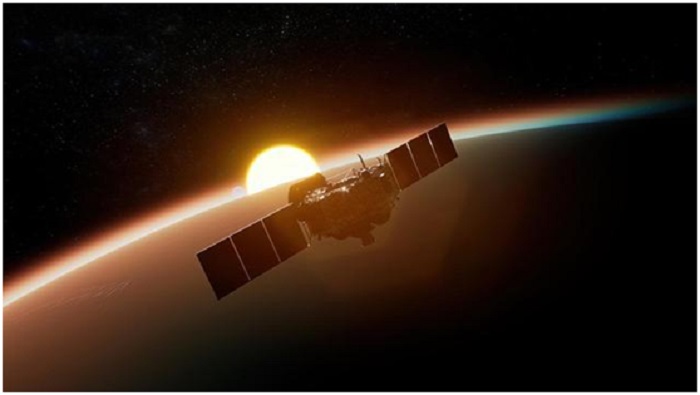



The orbiter of China’s Tianwen-1 Mars mission completed its fifth braking near Mars and entered its remote-sensing orbit around the red planet on Nov. 8, starting to carry out global remote-sensing exploration of Mars.
China’s Mars rover Zhurong, part of the Tianwen-1 mission, had accomplished its planned exploration and detection tasks and is now conducting additional tasks in good condition.
The research and development team of the mission optimized the design of the orbit according to the needs of the orbiter in conducting Mars detection and relaying communications between the Mars rover and Earth.
With the periareion, the point in the orbit that is closest to Mars, and the apoareion, the highest point of the orbit around Mars, adjusted to about 265 km and 10,700 km respectively, and the orbital period to around 7.08 hours, the improved design enables the Mars orbiter to carry out scientific exploration around Mars while better relay the communication for the rover, thus increasing the efficiency in the implementation of relevant tasks.
The Mars orbiter separated from the lander and rover of the Tianwen-1 mission on May 15. On the same day, the lander touched down on the red planet. After that, the orbiter entered orbit to relay communication between the rover and the Earth.
After relaying communication for the rover for more than four months, the orbiter shifted its orbit recently at the periareion and successfully entered its remote-sensing orbit around Mars.
According to experts, the relay orbit is a recursive orbit along which the orbiter orbited Mars three times a Martian day and passed over the landing site of the Tianwen-1 probe each Martian day, thus relaying communications between the rover and the Earth twice within a Martian day at the periareion and the apoareion, respectively.
With a shorter orbital period than that of the relay orbit, the remote-sensing orbit allows the orbiter to orbit the red planet 3.47 times a Martian day and pass different substellar points to carry out detection tasks in different regions, experts pointed out.
During the remote-sensing exploration of Mars, the scientific payloads aboard the Tianwen-1 orbiter can conduct relatively high-resolution observation of the planet at low orbital altitudes. By leveraging the drift of the periareion caused by orbital perturbations, the orbiter can carry out detection tasks covering the whole planet in the remote-sensing orbit.
In general, the periareion drifts from south to north, and then from north to south, which helps the orbiter complete a probe of global coverage into Mars within about 200 days.
The seven scientific payloads aboard the orbiter, including a medium-resolution camera, a high-resolution camera, a subsurface detection radar, a mineral spectrum analyzer, a magnetometer, an ion and neutral particle analyzer, and an energetic particle analyzer, will help it implement comprehensive scientific exploration and detection tasks around the red planet while continuing relaying communications for the Mars rover according to the rover’s visible arc.
The Tianwen-1 orbiter will operate in its remote-sensing orbit for 14 months, conducting high-resolution detection to obtain scientific data relating to morphology and geological structure, surface material composition and soil type distribution, the atmospheric ionosphere and the space environment of Mars.
In particular, the detection and explorations tasks will focus on typical landforms and geological units on Mars, such as meteor crater, volcano, canyon, and dry riverbed.
The orbiter had worked in orbit for 473 days as of Nov. 8, when its Earth-Mars distance was 384 million km and it took 21 minutes and 20 seconds for light to travel between the two planets.
The Mars rover of the Tianwen-1 mission had worked for 174 Martian days and moved a total distance of 1,253 meters on the Martian surface as of Monday. Both the orbiter and rover are in good condition and all relevant systems are functioning normally.
The communication between the Tianwen-1 probe and the Earth has been unstable and even interrupted due to solar electromagnetic radiation after late September this year. During the period, the orbiter and the rover suspended scientific exploration and switched to autonomous operation mode.
Since the sun outage ended recently, the remote measurement, control and communication between the probe and Earth has been resumed, the China National Space Administration (CNSA) said on Oct. 22.
According to telemetry data, the Tianwen-1 probe was in normal state during the sun outage, which means that the probe has gone through its first sun outage safely, the CNSA said.


The Executive and members of the.


The Acting Director, FCT Directorate of.


President Bola Ahmed Tinubu has been.



Barely a month after resignation of.


An Abuja based Legal Practitioner, Osuagwu.



Convener of Equitable Remedy, Mrs. Magaret.


Contractors handling the contract for city.


Nigerian government may have concluded plans.


The Diplomatic Correspondents Association of Nigeria.


A rights group, “Follow Me Talk.
Leave a Comment